Thymol, the essential oil present in all thyme plants, fills Australian gardens with an intoxicating savoury fragrance all through summer. The easiest way to achieve that unique aroma on a big scale is creeping thyme.
Creeping thyme is a beautiful Mediterranean herb, perfectly suited to rockeries, border edges and container gardens, and it can even thrive in balcony gardens. In this guide, we’re going to run through the best way to grow creeping thyme, propagation, and how to avoid some problematic diseases.
More...
Family: | Lamiaceae |
|---|---|
Genus | Thymus |
Species: | serpyllum |
Common Names: | Creeping thyme, wild thyme, elfin thyme |
Location: | Outdoor |
Type: | Mediterranean herb, perennial |
Growth: | H 10cm x W 1m |
Sun requirements: | Full sun |
Foliage Colour: | Green |
Flower Colour: | Whites, Reds, Purples |
Flowering: | Early summer |
Fruit: | None |
Maintenance level: | Low |
Poisonous for pets: | Non-toxic to cats and dogs |
What are Creeping Thymes?

Creeping thymes are a specific species of thyme (Thymus serpyllum) with many cultivars, all sharing the same trailing habit. They, like all thymes, are part of the mint (Lamiaceae family) and have similarly powerful essential oils.
Creeping thyme grows well in Australia and requires very little ongoing care, other than a trim once a year, and a little water to help see it through extreme drought.
Creeping thyme is a perennial herb, so returns every year, though may lose some of its flowering vigour after about five years.
One of the most intriguing modern uses of creeping thyme is as a lawn substitute. Creeping thyme helps to support native bees thanks to its prolific nectar-rich flowers, and its ability to withstand light foot traffic.
Natural Habitat of Thymus serpyllum
Creeping thyme is a Mediterranean herb by classification, rather than origin, and is found growing wild throughout Europe, Asia and North Africa.
There is no geographical prerequisite for Mediterranean plants. Instead, they are classified based on their characteristic and growing preferences.
Many of Australia’s native plants, particularly from the North East coast, are classified as Mediterranean, due to their preference for free draining soil, high temperatures and their ability to withstand salty winds.
Can you eat creeping thyme?
While creeping thyme isn’t native to Australia it makes a brilliant bush tucker plant for foragers as it has naturalised around the country. If you grow creeping thyme in your garden you can harvest the entire plant, but the stalks are woody and have a horrible texture.
The leaves and flowers of thyme are perfect for cooking, and salads, and share a similar flavour, though the flowers have a delicate sweetness as well as the iconic thymol taste.
Best Creeping Thymes to Grow in Australia
1. Spicy Orange thyme (Thymus serpyllum ‘Spicy Orange’)Spicy Orange thyme is a uniquely delicate thyme, with loose foliage and sprawling stems. Its clusters of pale pink flowers and elongated foliage look more like verbena than most members of the mint family. As a long-stemmed creeping thyme it is incredibly easy to propagate Spicy Orange thyme by division in spring or summer. |  Source: bluestoneperennials.com |
2. White creeping thyme (Thymus praecox ‘Alibiflorus’)The lime green foliage of Thymus ‘Albiflorus’ is a stunning addition to a rockery or raised bed, and trails freely over the sides or window boxes. But, if you want to make the most of this wonderfully white flowered thyme, grow it along the front of garden borders, where it will happily cover 50cm-1m of ground in a few years, and is easy to divide and move around the garden. |  |
3. Red creeping thyme (Thymus serpyllum ‘Coccineus’)Don’t believe the ridiculously photoshopped images of red creeping thyme online. Red creeping thyme has a delicate pinkish-purple hue to its flowers, but spends most of the year a grassy-green mound, growing in distinct domed clusters. | 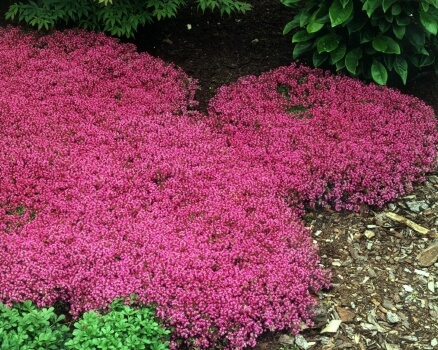 Source: hgtv.com |
4. Caraway thyme (Thymus herba-barona)Caraway thyme is a very specific species of thyme, native to Majorica and Corsica. Its soft papery foliage is perfect for cooking into sauces and has none of the tough texture of some other creeping thymes. Provide as much nutrition, and drainage as possible. | 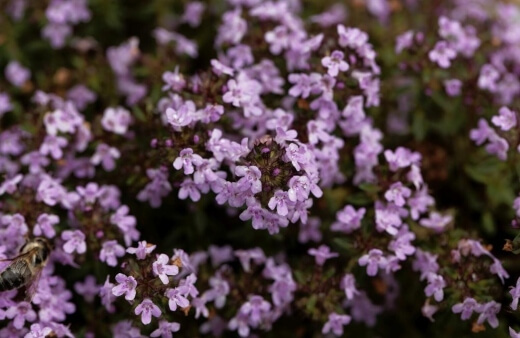 |
5. Woolly thyme (Thymus polytrichus)Woolly thyme is actually native to the UK and Western Europe so grows best in cooler conditions and is well suited to southern Australia and Tasmania where it can be allowed to overwinter in fairly natural conditions. | 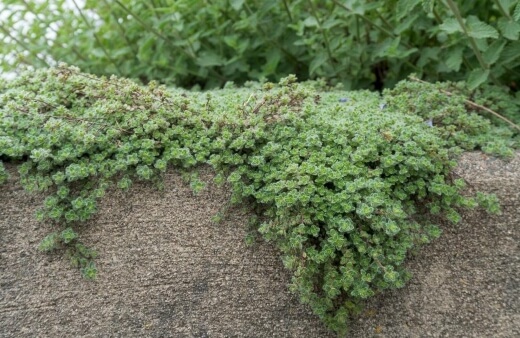 |
6. Archer’s gold thyme (Thymus pulegioides ‘Archers Gold’)I love Archer’s Gold thyme. Not for its colour (which is vivid), or its flavour (which is crisp and delicate) but for its unusual growth habit. Rather than being fully creeping, Archer’s Gold thyme is a ‘sub-shrub’, growing in a low, mounded form, which makes for even denser ground cover than most creeping thymes. Grow a few together or take regular cuttings to increase your stock. | 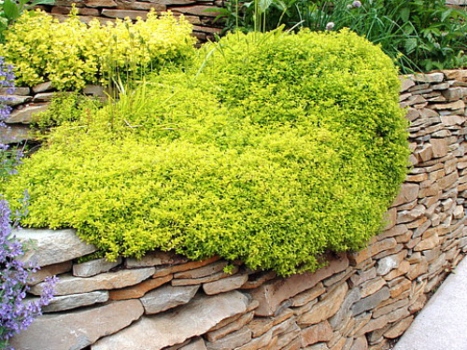 Source: walmart.com |
7. Pink Chintz thyme (Thymus serpyllum ‘Pink Chintz’)Pink chintz is a beautiful low-growing, matt-forming thyme, with pink flowers that turn purple in their centre. Its foliage is a bright emerald green, and it grows unevenly around borders, readily spreading, while still being easy to control, making it perfect for low-maintenance borders. |  Source: gaiaorganics.ca |
8. Snowdrift thyme (Thymus serpyllum ‘Snowdrift’)Snowdrift is one of the best flowering thymes for any garden, with dense, long lasting flowers that cover these creeping plants right through summer. Perfect for pots and hanging baskets. | 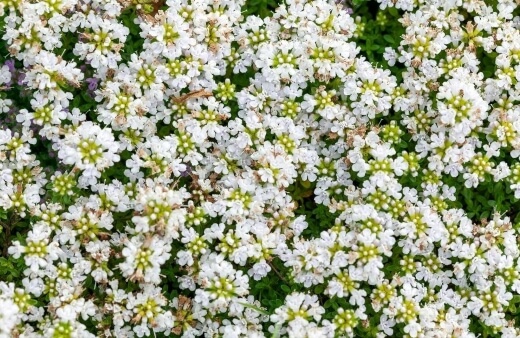 |
9. Creeping lemon thyme (Thymus serpyllum ‘Creeping Lemon’)Lemon thyme has a sweet lemony flavour, more like lemonade than fresh lemons, with none of the bitterness. I love how versatile the flavour palate of Lamiaceae can be, with tastes of strawberry, lemon, orange and even chocolate developing in different cultivars. | 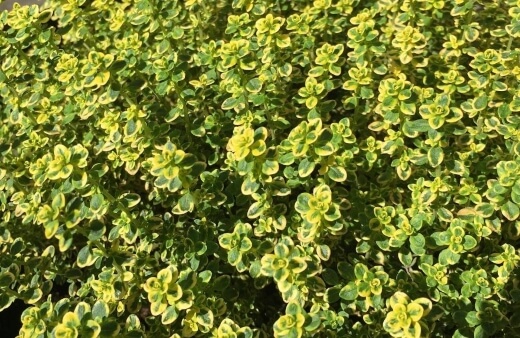 |
10. Variegated lemon thyme (Thymus ‘Lemon Variegated’)Variegated lemon thyme has gorgeous foliage, with tiny leaves bordered in bright white that fades into a silver-green. It grows well in full sun or partial shade, so is perfect for any corner of the garden where you’re likely to sit in the evening, benefitting from the scent, and the last signs of foliage as the sun goes down. | 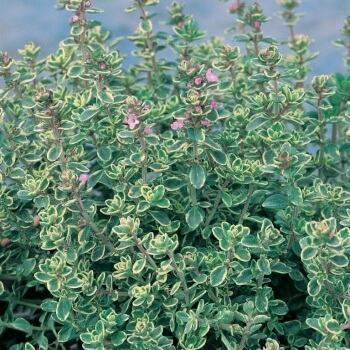 Source: flowerpower.com.au |
1. Spicy Orange thyme (Thymus serpyllum ‘Spicy Orange’)

Source: bluestoneperennials.com
Spicy Orange thyme is a uniquely delicate thyme, with loose foliage and sprawling stems. Its clusters of pale pink flowers and elongated foliage look more like verbena than most members of the mint family.
As a long-stemmed creeping thyme it is incredibly easy to propagate Spicy Orange thyme by division in spring or summer.
2. White creeping thyme (Thymus praecox ‘Alibiflorus’)

The lime green foliage of Thymus ‘Albiflorus’ is a stunning addition to a rockery or raised bed, and trails freely over the sides or window boxes.
But, if you want to make the most of this wonderfully white flowered thyme, grow it along the front of garden borders, where it will happily cover 50cm-1m of ground in a few years, and is easy to divide and move around the garden.
3. Red creeping thyme (Thymus serpyllum ‘Coccineus’)

Source: hgtv.com
Don’t believe the ridiculously photoshopped images of red creeping thyme online. Red creeping thyme has a delicate pinkish-purple hue to its flowers, but spends most of the year a grassy-green mound, growing in distinct domed clusters.
4. Caraway thyme (Thymus herba-barona)

Caraway thyme is a very specific species of thyme, native to Majorica and Corsica. Its soft papery foliage is perfect for cooking into sauces and has none of the tough texture of some other creeping thymes. Provide as much nutrition, and drainage as possible.
5. Woolly thyme (Thymus polytrichus)

Woolly thyme is actually native to the UK and Western Europe so grows best in cooler conditions and is well suited to southern Australia and Tasmania where it can be allowed to overwinter in fairly natural conditions.
6. Archer’s gold thyme (Thymus pulegioides ‘Archers Gold’)

Source: walmart.com
I love Archer’s Gold thyme. Not for its colour (which is vivid), or its flavour (which is crisp and delicate) but for its unusual growth habit.
Rather than being fully creeping, Archer’s Gold thyme is a ‘sub-shrub’, growing in a low, mounded form, which makes for even denser ground cover than most creeping thymes.
Grow a few together or take regular cuttings to increase your stock.
7. Pink Chintz thyme (Thymus serpyllum ‘Pink Chintz’)

Source: gaiaorganics.ca
Pink chintz is a beautiful low-growing, matt-forming thyme, with pink flowers that turn purple in their centre. Its foliage is a bright emerald green, and it grows unevenly around borders, readily spreading, while still being easy to control, making it perfect for low-maintenance borders.
8. Snowdrift thyme (Thymus serpyllum ‘Snowdrift’)

Snowdrift is one of the best flowering thymes for any garden, with dense, long lasting flowers that cover these creeping plants right through summer. Perfect for pots and hanging baskets.
9. Creeping lemon thyme (Thymus serpyllum ‘Creeping Lemon’)

Lemon thyme has a sweet lemony flavour, more like lemonade than fresh lemons, with none of the bitterness. I love how versatile the flavour palate of Lamiaceae can be, with tastes of strawberry, lemon, orange and even chocolate developing in different cultivars.
10. Variegated lemon thyme (Thymus ‘Lemon Variegated’)
Variegated lemon thyme has gorgeous foliage, with tiny leaves bordered in bright white that fades into a silver-green. It grows well in full sun or partial shade, so is perfect for any corner of the garden where you’re likely to sit in the evening, benefitting from the scent, and the last signs of foliage as the sun goes down.
How to Grow Creeping Thyme
Creeping thyme is easy to grow in most soils other than boggy, or dam conditions. Thyme likes good drainage and hates sitting in water, so most Australian garden soil is ideal, but for the best fragrance, mix in grit and compost to your garden soil to boost the production of essential oils.
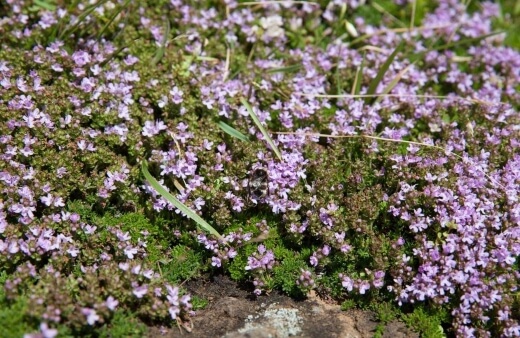
Let’s take a look at the specific growing requirements of creeping thyme, so you can provide your plants with their ideal habitat.
Growing Creeping Thyme Outdoors
Soil for Creeping Thyme
Provide creeping thyme with an equal mix of potting compost and grit. Rich balanced compost, either from the garden centre, or your own compost bins gives a good nutrient boost, and helps to hold fresh water around the roots, while grit limits the water and prevents stagnant water from causing root rot.
(If you are on the market for a compost bin, check out our comprehensive guide here).
You can use vermiculite or perlite as an alternative to grit, but, grit is a much more affordable way to provide thyme with conditions similar to its natural habitat.
Watering Schedule
Creeping thyme needs plenty of water to get established. It might sound counterintuitive for a plant that loves drainage, and is highly drought tolerant, but its roots can be slow to establish.
To help young plants out in their first spring and summer, water them generously once a week. Reduce that in the second year if there are clear signs of fresh foliage, and new stems.
Sunlight Preference
Creeping thyme grows best outdoors in full sun. While creeping thyme can cope with part shade it won’t thrive, and is not likely to spread and crawl around the base of other plants with the same vigour as in full sun.
Pruning
Like any creeping plant, thyme grows out from a genital root ball, and will eventually stop producing foliage at its centre. There are two ways to fix this.
The first is to take cuttings, or reproduce your plant by encouraging layering (full guide later in this article). The second is to prune back hard once a year.
Creeping thyme grows vigorously in late spring, and right through summer, so to maintain a fresh leafy form, cut back half the stems to a young branch in autumn.

How to Grow Creeping Thyme in Containers
Creeping thyme grows best outdoors but also makes an attractive kitchen plant – though regular watering and a large container are necessary to keep it in check.
Whether you grow your creeping thyme in pots outdoors, or indoors, the growing medium should be the same, and the light conditions mirror outdoor thyme.
Provide creeping thyme in containers with good compost, mixed with grit to aid drainage, and water only when the soil is dry at the surface. Place your pot in full sun, and trim excessive growth regularly to maintain a good shape.
Tip: For creeping thyme in pots indoors, place your container on a drip tray as water will drip right through the gritty compost mix onto your surface without one. Click here for more tips on growing herbs indoors.
Propagating Creeping Thyme
There are a few ways to propagate creeping thyme, but layering is by far the simplest. However, it requires space, and a lot of patience, so we’ve got guides to three options depending on the space you’ve got available.
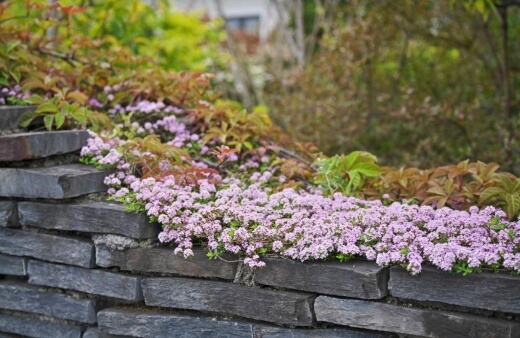
Creeping Thyme Propagation from Seed
Thyme grows well from seed, but germination can be erratic, so you will need to sow plenty in a seed tray to get a few good plants.
You can buy thyme seeds online, or pick them up at your local garden centre.
- Start by filling a shallow seed tray with gritty compost.
- Sow thyme generously across the surface (at least 1 seed per cm)
- Cover with a VERY thin layer of sieved compost (thyme needs light to germinate).
- Water gently so the surface of the soil is just damp.
- Place in a warm, sunny position on a windowsill, or in a greenhouse and keep the soil slightly damp.
- Germination can be quite slow, so keep checking them for up to three months.
- When seedlings germinate, thin them to 1 inch apart.
- When they are large enough to handle, prick them out into individual containers.
Propagating Thymus serpyllum from Cuttings
Thyme takes well from cuttings, but the young plants are very susceptible to root rot, so it's important to manage their water properly. Never let them sit in water, and create a very well-drained mix.
- Take 15cm cuttings from young stems in early summer.
- Trim the base of the cutting to just below a leaf node.
- Remove 75% of the leaves, so the cutting is mostly stem.
- Bury the cutting in a 50:50 mix of compost and vermiculite so just the top 4-5cm are showing above the soil.
- Keep in a warm, shady spot, out of direct sunlight, and keep humidity slightly above average.
- Either mist daily, or cover pots with polythene bags to lock in moisture.
- Cuttings will usually start to root after 1 week, but can take 1-2 months to show signs of new growth.
Propagating Creeping Thyme from Layering
Creeping thyme is called creeping thyme for two reasons: 1, it’s a low growing, spreading plant; 2, it actively roots from its stems, creating new plants as it grows.
Layering is just manipulating this natural process. Basically, when creeping thyme stems are in direct contact with the soil, they will try to root. You can encourage this by covering stems with a little soil, and keeping that point of the plant watered for a few weeks.
It can take around twelve months for a new plant to establish in isolation from its parent, but creeping thyme will often do this with no intervention, giving you plenty of plants to dig up, divide, and plant elsewhere.
Common Creeping Thyme Pests and Diseases
Creeping thyme has no common pests thanks to its potent essential oils. Like eucalyptus, mint and lemon balm, pests are put off by the strong scent of thyme’s foliage, while pollinators are attracted to its rich nectar.
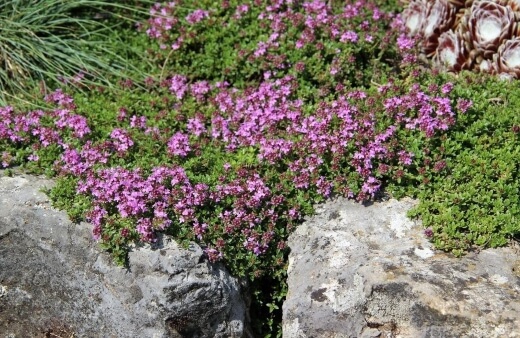
Spittle Bugs
The only pest in Australia that will actively damage thyme are spittle bugs. Throughout Europe, spittle bugs are closely observed as the culprit of Xylella fastidiosa, a bacterial disease that kills most Mediterranean plants.
Thankfully, it is not currently present in Australia and the limited number of spittle bugs that have been reported do not carry the disease.
Australia is a fairly safe haven for thyme, with very few diseases that actively affect the plant. The only problems that will significantly damage thyme are fungal diseases caused by damp conditions or overwatering.
Alternaria blight and botrytis
Alternaria blight and botrytis are the most common foliage diseases, and both cause significant dieback of thyme plants, which can be hard to control.
Remove any affected growth, and treat the rest of the plant with an organic fungicide like neem oil to reduce the spread. Allow the soil to dry out completely around each plant.
Root Rot
Root rot is most commonly caused by Rhizoctonia solani, a soil-borne fungus, spread by insects, wind, and rotting plant matter. Root rot is difficult to spot in creeping thyme, because it develops underground, and spreads up the stem, which is usually covered by foliage.
If your soil remains wet for long periods after watering, dig down into the soil and feel the roots. If they are slimy or at all squishy, consider repotting, or digging up your plants, and washing the roots.
Remove any dead roots, and replant in fresh soil, having removed the diseased soil and treated the area with organic fungicidal soil treatment.
Creeping Thyme Frequently Asked Questions

Does creeping thyme like acid or alkaline soil?
Creeping thyme prefers slightly alkaline soil with a pH of around 8-9, but grows well on neutral ground, or very slightly acidic soil. In general, thyme isn’t fussy about soil pH, but grows slightly more vigorously on alkaline soil.
How quickly does creeping thyme spread?
Creeping thyme starts to spread in its second growing season, usually taking its first year to establish roots, and settle into a new home. In its second year, it can grow up to 1ft per year.
Is creeping thyme good ground cover?
Creeping thyme is a useful plant for low-maintenance gardens and excellent ground cover. Thanks to its thick matt of foliage, creeping thyme helps to block out light to the soil, which reduces most annual weeds, and can limit the growth of deep-rooted weeds too.
Is creeping thyme evergreen?
In most parts of Australia creeping thyme will hold onto its foliage in winter, but will enter dormant seasons. In spring, new leaves will replace the old ones, so it is semi-deciduous rather than truly evergreen.
Savour the Fragrance Creeping Thyme will Bring to Your Garden
Creeping thyme is a perfect plant for any low-maintenance garden planted with nature in mind. While creeping thyme isn’t a native plant, its fragrant nectar-rich flowers and dense aromatic foliage help to repel pests and attract pollinators.
And if its beauty and usefulness weren’t enough, it’s completely edible too. I could talk all day about how to grow creeping thyme, but we’ve covered everything from sowing to harvest, so I’ll say that’s all we’ve got thyme (sorry) for.
Published on August 8, 2022 by Maisie Blevins
Last Updated on April 1, 2024




